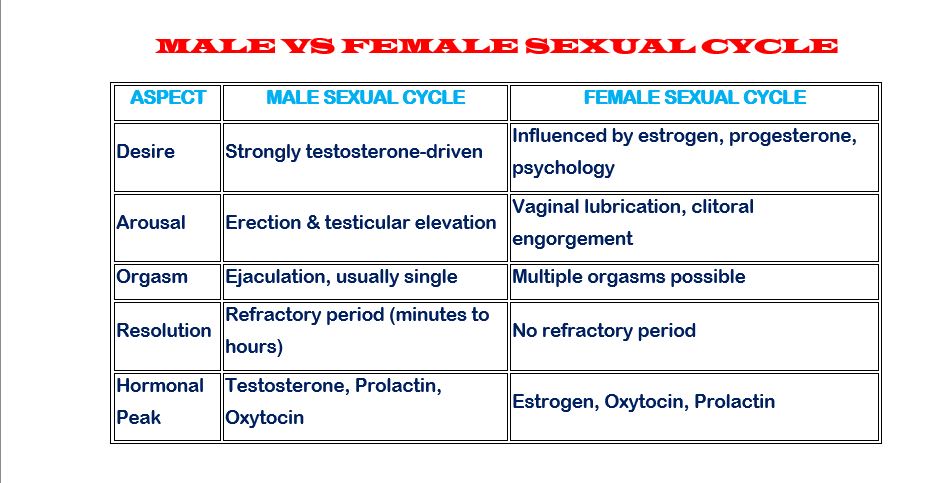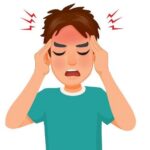Table of Contents
Sex and Human
Male and Female Sexual Cycle


The sexual cycle in males and females is a complex interplay of neurobiological, hormonal, psychological, and anatomical factors. It has been studied from biomedical, psychological, and also classical perspectives such as Ayurveda and Eastern philosophy. A comprehensive understanding requires exploring phases, mechanisms, gender differences, and health implications.
Concept of Sexual Cycle
The sexual cycle refers to the sequence of physiological and psychological events that occur during sexual arousal, activity, and recovery. Masters and Johnson (1960s) described it in four stages:
Excitement (Arousal)
Plateau
Orgasm (Climax)
Resolution
Later, Helen Singer Kaplan modified the model into three stages:
Desire → Arousal → Orgasm.
Ayurveda relates the sexual cycle to Vata, Pitta, and Kapha functions, particularly Shukra Dhatu (reproductive tissue) and Ojas (vital essence).
Male Sexual Cycle
Excitement / Desire Phase
Initiated by visual, tactile, auditory, olfactory, or fantasy stimuli.
Neuroendocrine: Dopamine release in the hypothalamus, parasympathetic activation.
Physiological changes:
Penile erection (mediated by nitric oxide and cGMP).
Increase in heart rate, blood pressure, and muscle tension.
Scrotal elevation and testicular enlargement.
Plateau Phase
Sustained erection and sexual tension.
Increased penile sensitivity and urethral gland secretion (Cowper’s glands).
Testes drawn closer to the perineum.
Heightened psychological focus.
Orgasmic Phase
Ejaculation occurs in two steps:
Emission: Semen collects in the posterior urethra.
Expulsion: Forceful contraction of bulbospongiosus and ischiocavernosus muscles.
Intense pleasure, loss of voluntary control.
Involvement of sympathetic nervous system.
Resolution Phase
Penis detumescence due to sympathetic vasoconstriction.
Refractory period: Temporary inability to achieve erection or orgasm (duration increases with age).
Female Sexual Cycle
Excitement / Desire Phase
Initiated by sensory and emotional stimuli.
Parasympathetic activation increases blood flow to the genitalia.
Physiological changes:
Vaginal lubrication (transudation from vaginal walls).
Clitoral erection and engorgement of labia minora.
Breasts and nipples become engorged.
Uterus elevates slightly.
Plateau Phase
Expansion of the lower vagina (orgasmic platform).
Marked increase in blood flow to clitoris and vulva.
Increased sexual tension and muscle contraction.
Orgasmic Phase
Intense rhythmic contractions (every 0.8 sec) of pelvic floor muscles, vagina, and uterus.
Clitoral and vaginal stimulation peaks.
Strong psychological sense of release and pleasure.
No emission/ejaculation equivalent to males (although female ejaculation from Skene’s glands is sometimes noted).
Resolution Phase
Clitoris, vagina, and uterus return to resting state.
Unlike men, women lack a refractory period, so multiple orgasms are possible.
Neuroendocrine Mechanisms
Dopamine → initiates desire and motivation.
Nitric oxide → penile/clitoral vasodilation.
Oxytocin → peak release during orgasm, promotes bonding and satisfaction.
Prolactin → post-orgasmic relaxation.
Testosterone (in both sexes) → drives libido.
Estrogen & Progesterone (in females) → influence lubrication, arousal, and sensitivity.
Ayurveda Perspective
Shukra Dhatu → Basis of reproductive vitality.
Vata Dosha → Governs erection and ejaculation.
Pitta Dosha → Governs sexual heat and orgasm.
Kapha Dosha → Governs lubrication and stability.
Excessive sex → Weakens Ojas, causes fatigue, and premature aging.
Balanced sexual activity (as per Ayurveda) → Enhances health, vitality, and emotional bonding.
Health Implications
Dysfunctions in Sexual Cycle:
Male: Erectile dysfunction, premature ejaculation, delayed ejaculation.
Female: Anorgasmia, hypoactive sexual desire disorder, vaginismus.
Psychosocial aspects: Stress, anxiety, relationship issues influence cycle.
Lifestyle impact: Sleep, diet, exercise, and substance use directly affect arousal and performance.
Conclusion
The male and female sexual cycles are both similar in phases but differ in physiological mechanisms, refractory capacity, and hormonal modulation. A holistic view recognizes not only the biological basis but also the psychological, relational, and spiritual dimensions of sexuality. Integrating modern science with Ayurveda provides a balanced framework for maintaining sexual health, reproductive vitality, and overall well-being.
Muscles, Joints, and Ligaments/Tendons used in Male Sexual Activity
Male Brain and Nervous System
Sexual activity begins with the brain. The nervous system receives sensory input and processes sexual stimuli, sending signals to the genital area to coordinate blood flow, arousal, and muscular responses. Proper neural function is critical for sexual performance and coordination.
Bones and Joints
Pelvic Bones: The pelvis forms the structural foundation for male genitalia, providing stability and leverage during sexual activity.
Sacroiliac Joints: These joints connect the pelvic bones and allow for controlled movement and stability of the lower body during sexual activity.
Male Pelvic Floor Muscles
The pelvic floor muscles play a central role in sexual function:
Levator Ani: Supports the bladder, rectum, and genital organs; contributes to sexual arousal and muscular control.
Ischiocavernosus and Bulbospongiosus Muscles: These muscles aid in erection, ejaculation, and rhythmic contractions during orgasm.
Puborectalis: Helps control urinary and anal sphincters, indirectly supporting sexual function.
Pelvic floor strength is directly linked to erectile function, ejaculatory control, and overall sexual health.
Ligaments and Tendons
Suspensory Ligament of the Penis: Anchors the penis to the pubic bone, stabilizing it during sexual activity.
Fundiform Ligament: Supports the penis from the abdominal wall and helps maintain optimal positioning during intercourse.
These ligaments provide structural support, allowing efficient and safe movement during sexual activity.
Male Sexual Health and Exercises
Kegel Exercises: Strengthen the pelvic floor muscles, improving erectile function, ejaculatory control, and overall sexual stamina.
Pelvic Floor Therapy: Professional interventions to improve muscle tone and coordination, enhancing sexual performance.
Male sexual activity involves a complex interaction of brain signals, pelvic muscles, ligaments, tendons, and joints. Proper muscular strength, joint stability, and ligament flexibility are crucial for effective sexual performance. Regular exercise, pelvic floor training, and maintaining a healthy lifestyle can significantly enhance sexual function.
Muscles, Joints and Ligaments/Tendons Used in Female Sexual Activity
Female Brain and Nervous System
Just like in men, female sexual activity starts with the brain. Sensory input (touch, sight, emotional bonding, hormonal triggers) activates the autonomic nervous system, leading to increased blood flow to the pelvic region, lubrication, and muscular responses. The parasympathetic system mainly promotes arousal, while the sympathetic system is involved in orgasmic contractions.
Bones and Joints
Pelvic Bones (ilium, ischium, pubis, sacrum, coccyx): Provide support for reproductive organs and form the foundation for movement during intercourse.
Hip Joints: Allow wide range of motion, flexibility, and positioning during sexual activity.
Sacroiliac Joints: Stabilize pelvic movement and transfer weight between spine and lower limbs.
Pelvic Floor Muscles
The female pelvic floor muscles are central to sexual activity:
Levator Ani Group (pubococcygeus, puborectalis, iliococcygeus)
Supports the bladder, uterus, and rectum.
Contracts during orgasm, producing rhythmic pulsations.
Important for vaginal tightness and pleasurable sensations.
Bulbospongiosus Muscle
Encircles the vaginal opening and clitoris.
Contracts during arousal and orgasm, enhancing clitoral sensitivity and tightening the vaginal canal.
Ischiocavernosus Muscle
Compresses veins around the clitoris, maintaining engorgement and sensitivity.
Superficial Transverse Perineal Muscles
Provide support to the pelvic floor and help coordinate contractions during sexual activity.
Ligaments and Tendons
Uterosacral Ligaments: Anchor the uterus to the sacrum, maintaining pelvic organ position during movement and sexual activity.
Round Ligament of the Uterus: Stabilizes the uterus, preventing excessive mobility.
Pubocervical and Cardinal Ligaments: Provide pelvic organ support, preventing prolapse during sexual activity.
Perineal Tendon (Central Tendinous Point of Perineum): Serves as the anchoring point for several perineal muscles, essential for sexual function and childbirth recovery.
Orgasmic Muscular Activity
During female orgasm, the following muscular responses occur:
Rhythmic contractions of the pelvic floor (pubococcygeus and bulbospongiosus)
Clitoral and vaginal engorgement supported by ischiocavernosus muscle
Uterine and vaginal contractions mediated by autonomic nerves
These muscular and ligamentous interactions enhance sexual pleasure, reproduction, and overall pelvic health.
Exercises and Female Sexual Health
Kegel Exercises: Improve pelvic floor strength, vaginal tone, lubrication, and orgasm intensity.
Yoga & Hip Flexibility Workouts: Enhance blood flow and joint flexibility.
Pelvic Floor Therapy: Helps with sexual dysfunction, incontinence, and post-childbirth recovery.
Summary
Female sexual activity involves an intricate interplay of brain signals, pelvic bones, hip joints, pelvic floor muscles, and supportive ligaments/tendons. The levator ani, bulbospongiosus, and ischiocavernosus muscles are the key muscular players, while the uterine and pelvic ligaments ensure stability. Strong, flexible, and healthy pelvic support structures enhance sexual function, pleasure, and reproductive health.
Benefits and Harms of Human Sex
Benefits of Human Sex
Physical Health Benefits
Cardiovascular health: Sexual activity increases heart rate, improves blood circulation, and can reduce the risk of hypertension when practiced moderately.
Hormonal balance: Promotes the release of oxytocin, endorphins, dopamine, and prolactin, which regulate mood, stress, and reproductive functions.
Pain relief: Natural endorphins released during orgasm help reduce headache, menstrual cramps, and joint pain.
Immunity boost: Regular sexual activity has been associated with higher levels of immunoglobulin A (IgA), improving immune defense.
Pelvic floor strengthening: Orgasms and pelvic contractions strengthen pelvic muscles, preventing urinary incontinence (especially in women).
Psychological and Emotional Benefits
Stress reduction: Oxytocin and endorphins released during sex lower cortisol (stress hormone) levels.
Better sleep: Post-orgasm relaxation improves sleep quality.
Mood enhancement: Increased dopamine improves happiness and motivation.
Emotional bonding: Sexual intimacy fosters closeness, trust, and attachment in relationships.
Reproductive and Evolutionary Benefits
Procreation: Fundamental for reproduction and continuation of human species.
Fertility enhancement: Frequent sexual activity may improve sperm quality in men and regulate menstrual cycles in women.
Mate bonding: Sexual intimacy strengthens pair-bonding, important for family and child-rearing.
Social and Relational Benefits
Relationship satisfaction: Healthy sexual relations improve marital and partner satisfaction.
Conflict resolution: Intimacy can reduce tension and strengthen communication.
Self-esteem: Positive sexual experiences can boost confidence and body image.
Harms of Human Sex
Physical Risks
Sexually Transmitted Infections (STIs): HIV, syphilis, gonorrhea, chlamydia, HPV, and herpes can spread through unprotected sex.
Unintended pregnancy: Lack of contraception can lead to unwanted pregnancies and related complications.
Pelvic and genital injuries: Rough or improper sexual activity may cause trauma, pain, or dysfunction.
Psychological Risks
Addiction and compulsion: Excessive or compulsive sexual activity can lead to psychological distress.
Guilt and shame: Cultural or religious stigma around sex may cause guilt and mental conflict.
Emotional imbalance: Casual or non-consensual encounters can result in regret, anxiety, or depression.
Social Harms
Relationship conflicts: Infidelity, mismatched libido, or dissatisfaction can strain relationships.
Exploitation and abuse: Sexual coercion, harassment, and assault are major societal harms.
Sex trafficking and commercialization: When sex is commodified, it can perpetuate exploitation.
Health Complications of Excessive or Unsafe Sex
Pelvic floor dysfunction: Overuse may weaken pelvic structures over time.
Erectile dysfunction or vaginal pain: Can result from physical or psychological strain.
Mental burnout: Excessive focus on sexual gratification may cause fatigue, distraction, or decreased productivity.
Balanced Perspective (Ayurveda & Modern View)
In Ayurveda:
Sex (Maithuna) is one of the Trayo Upasthambha (three pillars of life) when practiced in moderation.
Excess sex causes Ojas depletion (vital energy loss), fatigue, and premature aging.
Controlled, seasonal, and mindful sex is recommended for health and longevity.
In Modern Medicine:
Regular, safe sex is healthy for the body and mind.
Unsafe, compulsive, or excessive sex can cause serious harm.
Conclusion
Sex is a natural human need with profound biological, psychological, and social benefits when practiced safely, consensually, and moderately. However, unprotected, exploitative, or excessive sexual activity carries risks of disease, emotional distress, and social harm.
A balanced, respectful, and responsible approach ensures that human sexuality remains a source of health, joy, and connection, rather than harm.
Sex and Human Sex and Human Sex and Human Sex and Human Sex and Human Sex and Human Sex and Human Sex and Human Sex and Human Sex and Human Sex and Human Sex and Human Sex and Human Sex and Human Sex and Human Sex and Human Sex and Human Sex and Human Sex and Human Sex and Human


